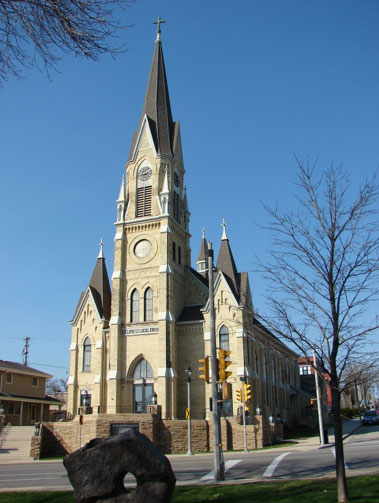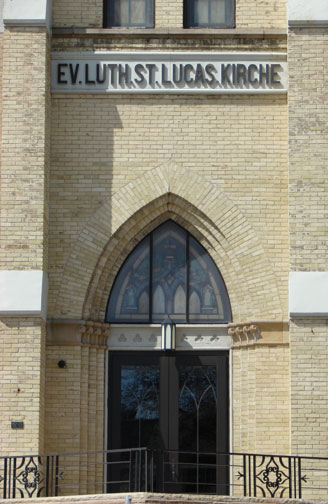30. St. Lucas Lutheran, 1888
2605 South Kinickinnic Avenue (at Dover Street)
Architect: Herman Schnetzky
A group of German immigrants in Bay View formed St. Lucas Evangelical Lutheran Church in 1872. At that time, Bay View was an unincorporated settlement growing in tandem with the Milwaukee Iron Company works along the Lake Michigan shoreline. The Milwaukee Iron Company donated land for the congregation’s first church, just as the company had done two years earlier for the Catholic parish of Immaculate Conception. St. Lucas congregation built a modest wooden church on the property, which was converted to a school after completion of the present church and was later demolished.
Bay View incorporated as a village in 1879, and the village in turn was annexed by the City of Milwaukee in 1887. The following spring, the congregation of St. Lucas began construction of a new and larger church of brick. Construction proceeded rapidly and the new church was dedicated in October. The spire atop the building’s central tower was described at the time as 136 feet in height, while the only other structures in Bay View of comparable height would have been the smokestacks of the iron mill. However, the church is located at a relatively low elevation along Kinnickinnic Avenue, so the spire does not loom over its neighborhood to the extent that many of the city’s other church spires loom over their neighborhoods.
The church commissioned architect Herman P. Schnetzky (1849-1916) to design its new place of worship. Schnetzky was born in the town of Wriezen in the Kingdom of Prussia, now northeastern Germany near the German-Polish border. He came to Milwaukee as a young man and worked in the office of H.C. Koch and Company from 1874 or a bit earlier. After more than a dozen years in the office of Henry Koch (who was Schnetzky’s brother-in-law), he established his own office in 1887. Schnetzky’s design for St. Lucas Lutheran is quite similar to his design for St. Martini Lutheran, built just a year prior to St. Lucas on Cesar Chavez Drive and Orchard Street on the South Side. He went on to design at least five other churches in Milwaukee by 1896, under his own name and in partnership with Eugene Liebert.
The exterior of St. Lucas Lutheran appears essentially as it was built more than 125 years ago, except for small additions at the rear. The tower clock dates to 1901, while the present terrace and stairs were installed in the late 1940s, replacing the original broad steps leading up to the front entrance. The clock was electrified in 1972 as part of renovations undertaken for the centennial of the church. The exterior of the building was also cleaned in that year, restoring the brick walls to their original yellow color.
Services at St. Lucas Lutheran were conducted entirely in German for more than four decades after the founding of the congregation. The constitution of the church, originally written in German, was revised and rewritten in English in 1926, and English replaced German for Sunday school classes the following year. The first regular services in English began just after World War I, while regular services in German continued into the mid-1960s.
Sources:
“Architect Who Designed Big Buildings is Dead,” Milwaukee Sentinel, February 22, 1916, page 1, column 4.
“City of Churches,” Milwaukee Sentinel, May 13, 1888, page 11, column 6.
Gurda, John. The Making of Milwaukee. Milwaukee County Historical Society, 1999.
A History and Family Pictorial Directory of St. Lucas Evangelical Lutheran Church. St. Lucas Church, 1972.
Nickel, Albert G. and Selma M. Koehler. A History of St. Lucas Evangelical Lutheran Church. 85th Anniversary, 1872-1957. St. Lucas Church, 1957.
O’Brien, William P. “Milwaukee Architect: Henry C. Koch.” M.A. Thesis, University of Wisconsin – Milwaukee, 1989.
“St. Lucas 90 Years Old,” Milwaukee Sentinel, October 20, 1962, part 1, page 9, column 2.

